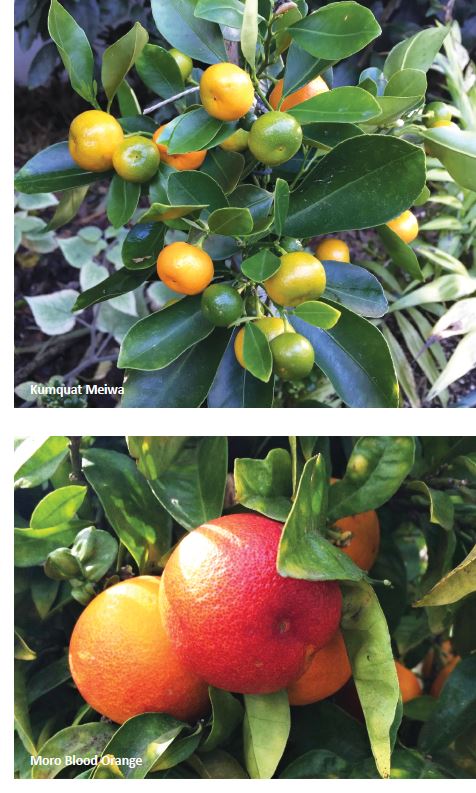Citrus shows, citrus competitions, citrus festivals, and the quickly approaching citrus and fruit tree sales seems to be the perfect time to address the subject of citrus for Galveston. What to plant, when to plant and how to plant; the key issues when making citrus selections for your garden.
“Home-grown citrus is of superior quality to supermarket fruits. Many residents grow citrus not only for the fruit but also for the ornamental value these trees provide to the landscape,” said Dr. William Johnson, former horticultural extension agent with the Galveston County Extension Office. “Some types of citruses are easier to grow than many traditional fruit trees.”
Numerous varieties can be grown successfully in our area such as Mexican lime, Nagami kumquat, Navel orange, and Moro blood orange, as well as Valencia orange, Honey tangerine, Rio Red grapefruit, and Meyer lemon.
Some local gardeners have trees that bear so much fruit that they are willing to share with all their neighbors. “Just come and pick what you want and take it away, please” said one close acquaintance recently.
In February, the citrus sales will begin. All over the Houston and Galveston area, master gardeners will be making prime stock especially developed for our region available at their annual citrus and fruit trees sale.
These trees have been grafted onto rootstock that have proven historical records of exceptional performance in local landscapes and gardens. They are varieties that will thrive and flourish in Galveston providing a bountiful and rewarding harvest each year.
Once you select which citrus trees you want for your garden it’s important to plant them in full sun - the more sun provided the better. Most citrus trees are generally not too fussy about the soil but do need good drainage, moderate water (not soggy) and a monthly application of nitrogen from March through August. Mature trees (those four years or older) may need to be fertilized only once in March.
 Citrus requires a minimum of pruning, best done in February, to remove dead wood or suckers. Keep in mind that heavy pruning may slow fruit production. Mulch with compost or other organic material making sure that the mulch does not touch the trunk of the tree.
Citrus requires a minimum of pruning, best done in February, to remove dead wood or suckers. Keep in mind that heavy pruning may slow fruit production. Mulch with compost or other organic material making sure that the mulch does not touch the trunk of the tree.
Flower and fruit drop are unavoidable but remember as your tree matures, it will produce an abundant crop year after year. Meanwhile, enjoy the swallowtail butterflies and the local bees that are visiting and enjoying your choice of citrus trees.
RECOMMENDED CITRUS TREES FOR OUR AREA
Mexican Thornless Lime
According to research, the most fashionable citrus tree now is the lime tree. Mexican, Persian and Key limes are most in the demand that has built up significantly over the last few years, probably because they are so popular in the Asian cooking trend that has become fashionable of late.
Limes are an excellent source of Vitamin C and a great substitute for lemons. They can be used for seafood dishes, chicken, meats, drinks, desserts, cakes, biscuits, and marmalade. The lime is valued both for the acidity of its juice and the floral aroma of its zest.
The Mexican thornless is a tree that has small excellent quality fruit recommended for use in pies and limeade (as well as many of our favorite cocktails). The Mexican lime is not cold tolerant but can be grown in containers that could be moved in the event of inclement weather.
Meyer Lemon
Also grown easily in a container, the Meyer lemon bears large fruit with a pleasing taste; this tree is a heavy producer although not cold tolerant so must be protected in extreme temperatures.
Kumquat Meiwa and Nagami Kumquat
The Meiwa kumquat has large round very sweet fruit that is excellent for eating, as the skin and all is edible. This heavy bearer of fruit can survive cold temperatures of 20 degrees or less; an ornamental plant that can be grown in a container.
The Nagami kumquat is an edible fruit that more resembles a small oval orange about the size of an olive that can withstand frost and low temperatures into the teens. Kumquat trees, although slow growing, may reach heights of eight or more feet.
They can tolerate our seaside environment, do not require extensive grooming or pruning, are rarely bothered by pests or disease, and can produce a bounty of hundreds of fruits every year.
Rio Red Grapefruit
The Rio Red is a mutation of the familiar Ruby Red variety, is deeper in color, less acidic and much sweeter, often claimed to be the sweetest grapefruit of any type. The result is large plump fruit with deep red flesh, this tree is often sold as a dwarf tree making it an excellent choice for container growing. This variety is cold weather hardy in our zone.
Popular Orange Trees
The Moro blood orange tree produces a fruit that is very dark in color, almost a deep red, very juicy, and sweet with medium sized fruit that is easy to peel and usually seedless.
The Republic of Texas orange is another citrus tree that is popular in our area that has been grown in the Angleton area since 1847. It is very cold tolerant with fruit that is sweet and flavorful.
Also often grown locally are the well-known Valencia orange and the always popular Navel orange, both good producers with a plentiful harvest of fruit that is sweet and juicy.